A Study on the Development & Impacts of Contemporary Tourism Industry
VerifiedAdded on 2023/06/09
|8
|2370
|313
Essay
AI Summary
This essay provides an overview of contemporary tourism, highlighting its development and the multifaceted impacts it has on economic, environmental, and socio-cultural aspects. It discusses how the tourism industry, while contributing significantly to a country's GDP and creating employment opportunities, also faces challenges from external factors like pandemics and natural calamities. The essay delves into the positive impacts, such as promoting historical site preservation and cultural exchange, and the negative impacts, including pollution, resource depletion, and potential social disruptions. It concludes that while tourism is a vital industry, sustainable practices and responsible management are crucial to mitigate its adverse effects and maximize its benefits for both the economy and the environment. Desklib offers a platform to explore more solved assignments and study resources for students.
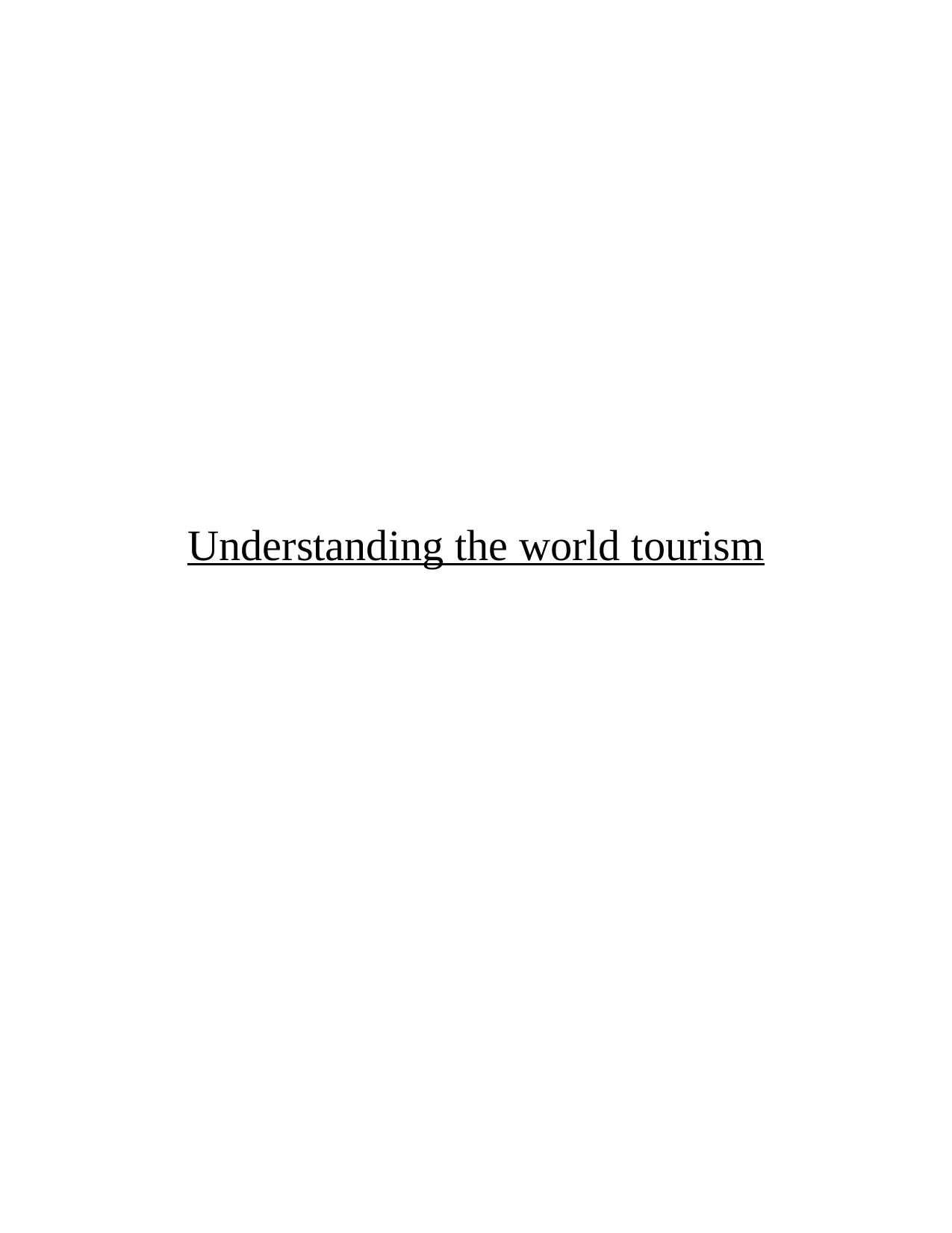
Understanding the world tourism
Paraphrase This Document
Need a fresh take? Get an instant paraphrase of this document with our AI Paraphraser
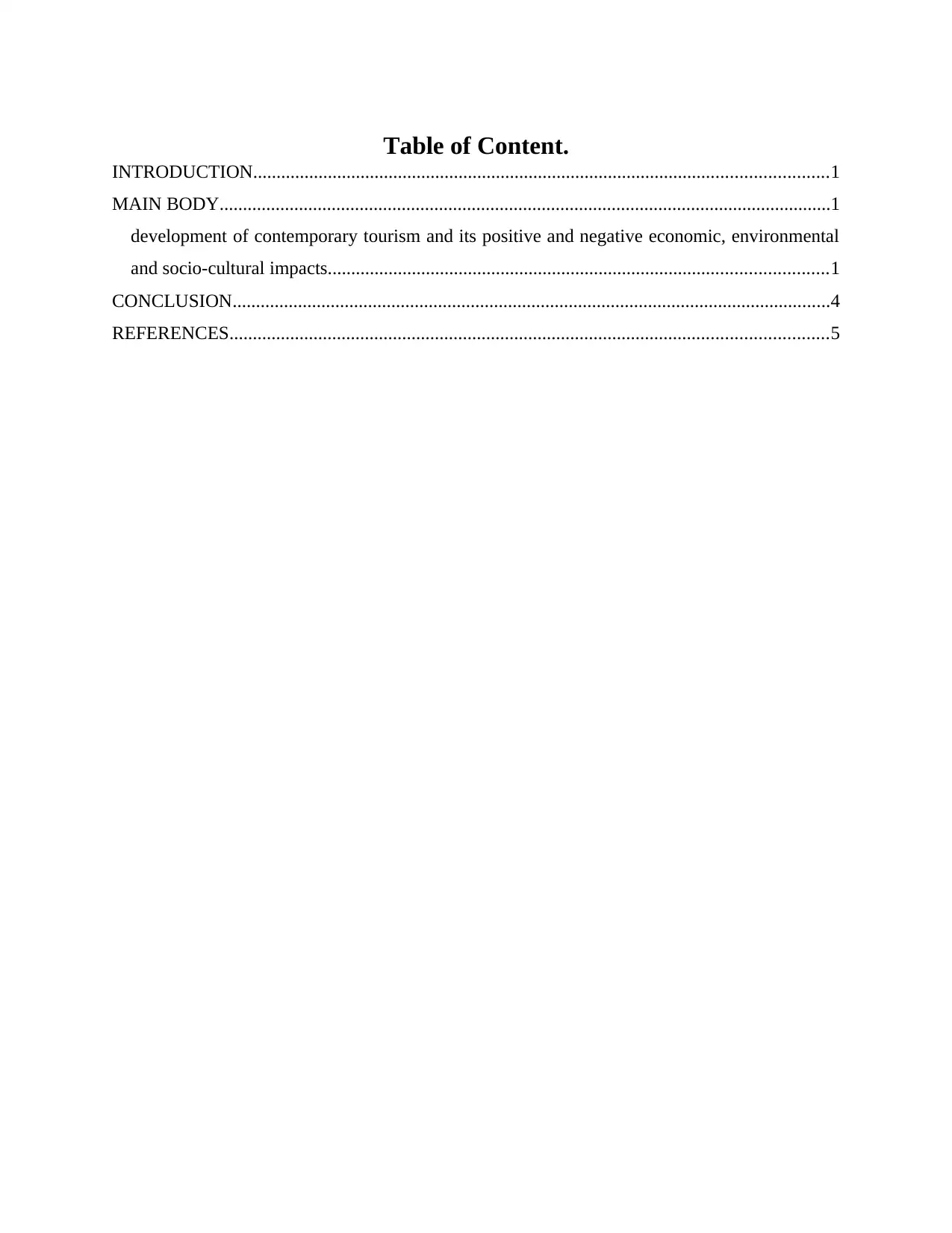
Table of Content.
INTRODUCTION...........................................................................................................................1
MAIN BODY...................................................................................................................................1
development of contemporary tourism and its positive and negative economic, environmental
and socio-cultural impacts...........................................................................................................1
CONCLUSION................................................................................................................................4
REFERENCES................................................................................................................................5
INTRODUCTION...........................................................................................................................1
MAIN BODY...................................................................................................................................1
development of contemporary tourism and its positive and negative economic, environmental
and socio-cultural impacts...........................................................................................................1
CONCLUSION................................................................................................................................4
REFERENCES................................................................................................................................5
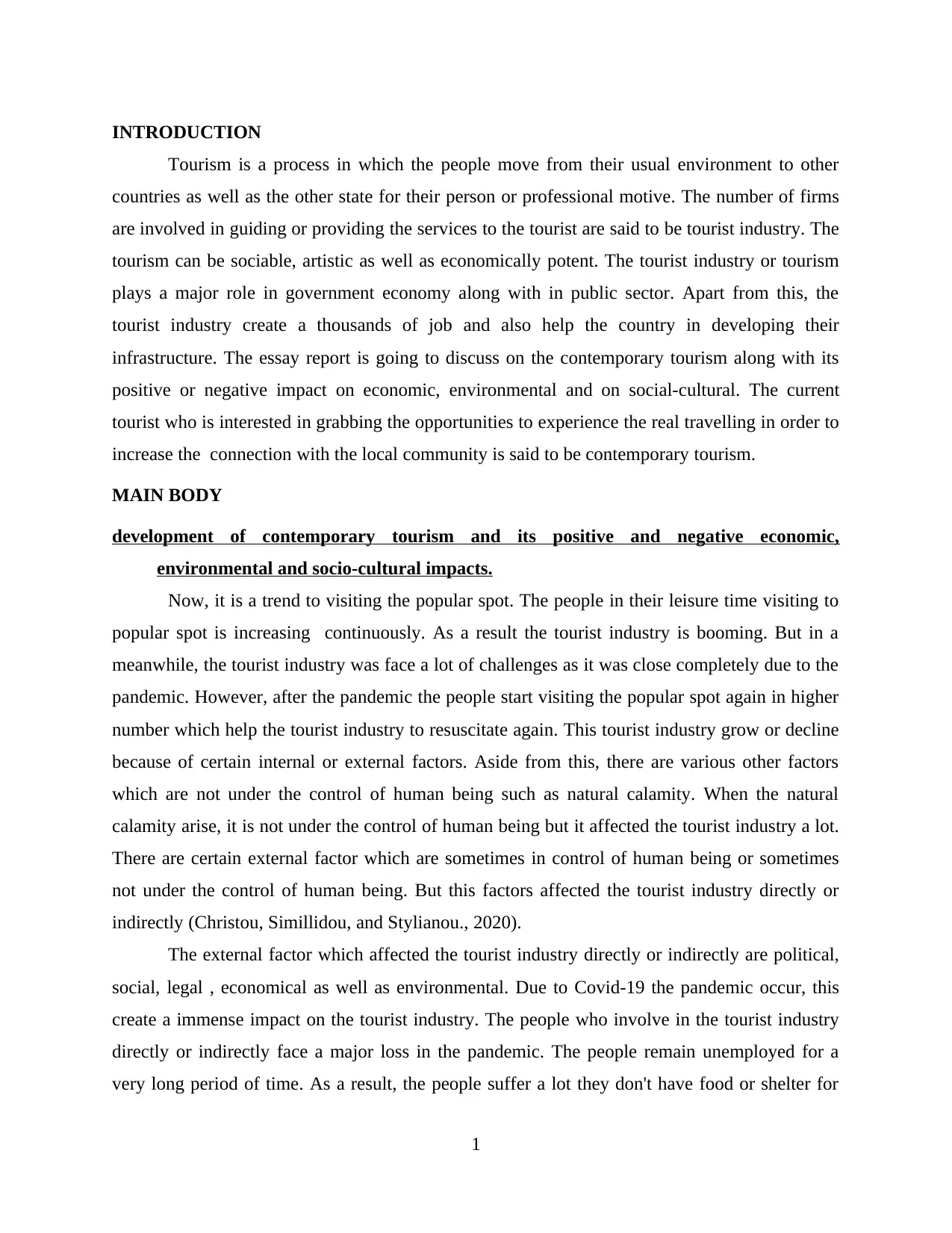
INTRODUCTION
Tourism is a process in which the people move from their usual environment to other
countries as well as the other state for their person or professional motive. The number of firms
are involved in guiding or providing the services to the tourist are said to be tourist industry. The
tourism can be sociable, artistic as well as economically potent. The tourist industry or tourism
plays a major role in government economy along with in public sector. Apart from this, the
tourist industry create a thousands of job and also help the country in developing their
infrastructure. The essay report is going to discuss on the contemporary tourism along with its
positive or negative impact on economic, environmental and on social-cultural. The current
tourist who is interested in grabbing the opportunities to experience the real travelling in order to
increase the connection with the local community is said to be contemporary tourism.
MAIN BODY
development of contemporary tourism and its positive and negative economic,
environmental and socio-cultural impacts.
Now, it is a trend to visiting the popular spot. The people in their leisure time visiting to
popular spot is increasing continuously. As a result the tourist industry is booming. But in a
meanwhile, the tourist industry was face a lot of challenges as it was close completely due to the
pandemic. However, after the pandemic the people start visiting the popular spot again in higher
number which help the tourist industry to resuscitate again. This tourist industry grow or decline
because of certain internal or external factors. Aside from this, there are various other factors
which are not under the control of human being such as natural calamity. When the natural
calamity arise, it is not under the control of human being but it affected the tourist industry a lot.
There are certain external factor which are sometimes in control of human being or sometimes
not under the control of human being. But this factors affected the tourist industry directly or
indirectly (Christou, Simillidou, and Stylianou., 2020).
The external factor which affected the tourist industry directly or indirectly are political,
social, legal , economical as well as environmental. Due to Covid-19 the pandemic occur, this
create a immense impact on the tourist industry. The people who involve in the tourist industry
directly or indirectly face a major loss in the pandemic. The people remain unemployed for a
very long period of time. As a result, the people suffer a lot they don't have food or shelter for
1
Tourism is a process in which the people move from their usual environment to other
countries as well as the other state for their person or professional motive. The number of firms
are involved in guiding or providing the services to the tourist are said to be tourist industry. The
tourism can be sociable, artistic as well as economically potent. The tourist industry or tourism
plays a major role in government economy along with in public sector. Apart from this, the
tourist industry create a thousands of job and also help the country in developing their
infrastructure. The essay report is going to discuss on the contemporary tourism along with its
positive or negative impact on economic, environmental and on social-cultural. The current
tourist who is interested in grabbing the opportunities to experience the real travelling in order to
increase the connection with the local community is said to be contemporary tourism.
MAIN BODY
development of contemporary tourism and its positive and negative economic,
environmental and socio-cultural impacts.
Now, it is a trend to visiting the popular spot. The people in their leisure time visiting to
popular spot is increasing continuously. As a result the tourist industry is booming. But in a
meanwhile, the tourist industry was face a lot of challenges as it was close completely due to the
pandemic. However, after the pandemic the people start visiting the popular spot again in higher
number which help the tourist industry to resuscitate again. This tourist industry grow or decline
because of certain internal or external factors. Aside from this, there are various other factors
which are not under the control of human being such as natural calamity. When the natural
calamity arise, it is not under the control of human being but it affected the tourist industry a lot.
There are certain external factor which are sometimes in control of human being or sometimes
not under the control of human being. But this factors affected the tourist industry directly or
indirectly (Christou, Simillidou, and Stylianou., 2020).
The external factor which affected the tourist industry directly or indirectly are political,
social, legal , economical as well as environmental. Due to Covid-19 the pandemic occur, this
create a immense impact on the tourist industry. The people who involve in the tourist industry
directly or indirectly face a major loss in the pandemic. The people remain unemployed for a
very long period of time. As a result, the people suffer a lot they don't have food or shelter for
1
⊘ This is a preview!⊘
Do you want full access?
Subscribe today to unlock all pages.

Trusted by 1+ million students worldwide
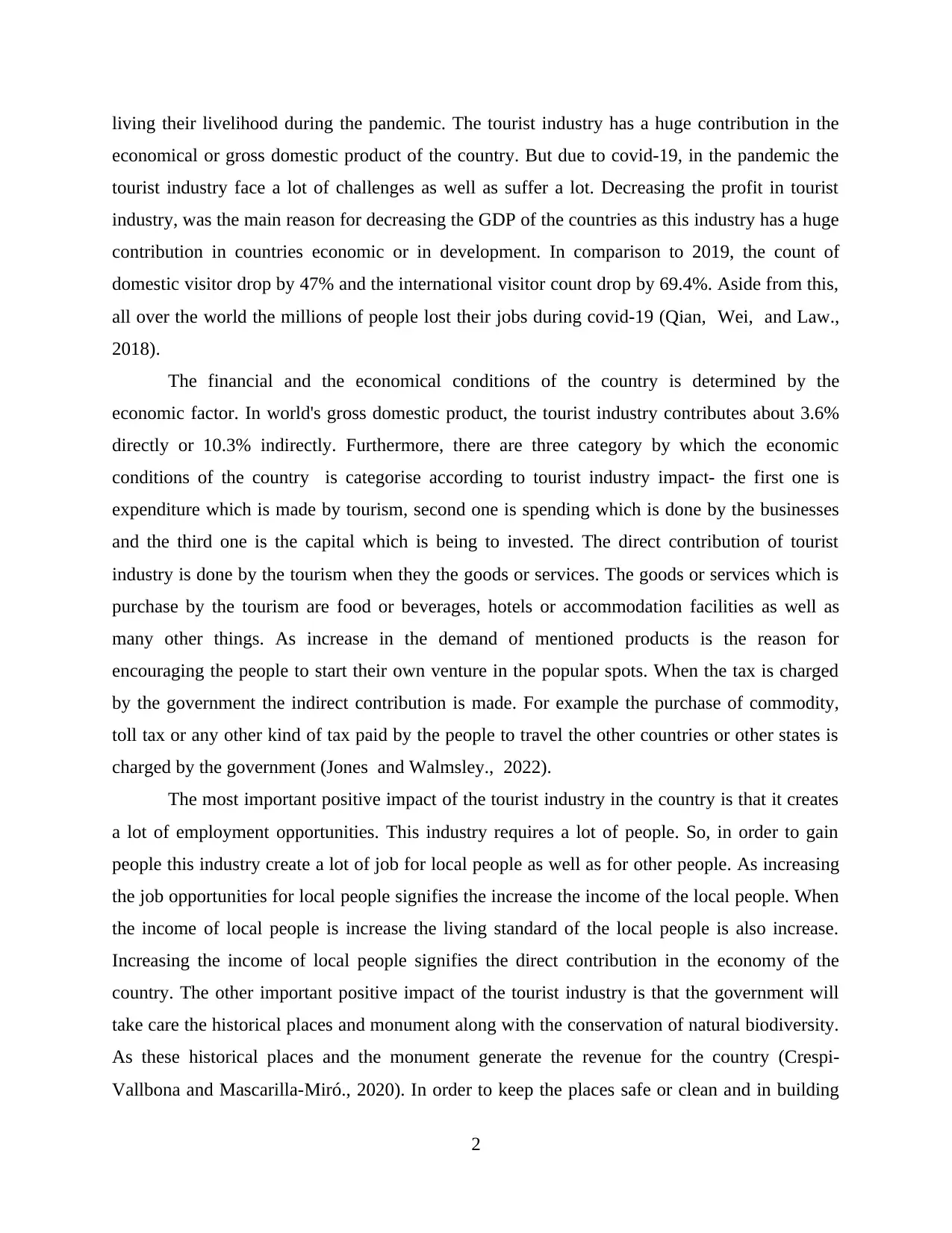
living their livelihood during the pandemic. The tourist industry has a huge contribution in the
economical or gross domestic product of the country. But due to covid-19, in the pandemic the
tourist industry face a lot of challenges as well as suffer a lot. Decreasing the profit in tourist
industry, was the main reason for decreasing the GDP of the countries as this industry has a huge
contribution in countries economic or in development. In comparison to 2019, the count of
domestic visitor drop by 47% and the international visitor count drop by 69.4%. Aside from this,
all over the world the millions of people lost their jobs during covid-19 (Qian, Wei, and Law.,
2018).
The financial and the economical conditions of the country is determined by the
economic factor. In world's gross domestic product, the tourist industry contributes about 3.6%
directly or 10.3% indirectly. Furthermore, there are three category by which the economic
conditions of the country is categorise according to tourist industry impact- the first one is
expenditure which is made by tourism, second one is spending which is done by the businesses
and the third one is the capital which is being to invested. The direct contribution of tourist
industry is done by the tourism when they the goods or services. The goods or services which is
purchase by the tourism are food or beverages, hotels or accommodation facilities as well as
many other things. As increase in the demand of mentioned products is the reason for
encouraging the people to start their own venture in the popular spots. When the tax is charged
by the government the indirect contribution is made. For example the purchase of commodity,
toll tax or any other kind of tax paid by the people to travel the other countries or other states is
charged by the government (Jones and Walmsley., 2022).
The most important positive impact of the tourist industry in the country is that it creates
a lot of employment opportunities. This industry requires a lot of people. So, in order to gain
people this industry create a lot of job for local people as well as for other people. As increasing
the job opportunities for local people signifies the increase the income of the local people. When
the income of local people is increase the living standard of the local people is also increase.
Increasing the income of local people signifies the direct contribution in the economy of the
country. The other important positive impact of the tourist industry is that the government will
take care the historical places and monument along with the conservation of natural biodiversity.
As these historical places and the monument generate the revenue for the country (Crespi-
Vallbona and Mascarilla-Miró., 2020). In order to keep the places safe or clean and in building
2
economical or gross domestic product of the country. But due to covid-19, in the pandemic the
tourist industry face a lot of challenges as well as suffer a lot. Decreasing the profit in tourist
industry, was the main reason for decreasing the GDP of the countries as this industry has a huge
contribution in countries economic or in development. In comparison to 2019, the count of
domestic visitor drop by 47% and the international visitor count drop by 69.4%. Aside from this,
all over the world the millions of people lost their jobs during covid-19 (Qian, Wei, and Law.,
2018).
The financial and the economical conditions of the country is determined by the
economic factor. In world's gross domestic product, the tourist industry contributes about 3.6%
directly or 10.3% indirectly. Furthermore, there are three category by which the economic
conditions of the country is categorise according to tourist industry impact- the first one is
expenditure which is made by tourism, second one is spending which is done by the businesses
and the third one is the capital which is being to invested. The direct contribution of tourist
industry is done by the tourism when they the goods or services. The goods or services which is
purchase by the tourism are food or beverages, hotels or accommodation facilities as well as
many other things. As increase in the demand of mentioned products is the reason for
encouraging the people to start their own venture in the popular spots. When the tax is charged
by the government the indirect contribution is made. For example the purchase of commodity,
toll tax or any other kind of tax paid by the people to travel the other countries or other states is
charged by the government (Jones and Walmsley., 2022).
The most important positive impact of the tourist industry in the country is that it creates
a lot of employment opportunities. This industry requires a lot of people. So, in order to gain
people this industry create a lot of job for local people as well as for other people. As increasing
the job opportunities for local people signifies the increase the income of the local people. When
the income of local people is increase the living standard of the local people is also increase.
Increasing the income of local people signifies the direct contribution in the economy of the
country. The other important positive impact of the tourist industry is that the government will
take care the historical places and monument along with the conservation of natural biodiversity.
As these historical places and the monument generate the revenue for the country (Crespi-
Vallbona and Mascarilla-Miró., 2020). In order to keep the places safe or clean and in building
2
Paraphrase This Document
Need a fresh take? Get an instant paraphrase of this document with our AI Paraphraser
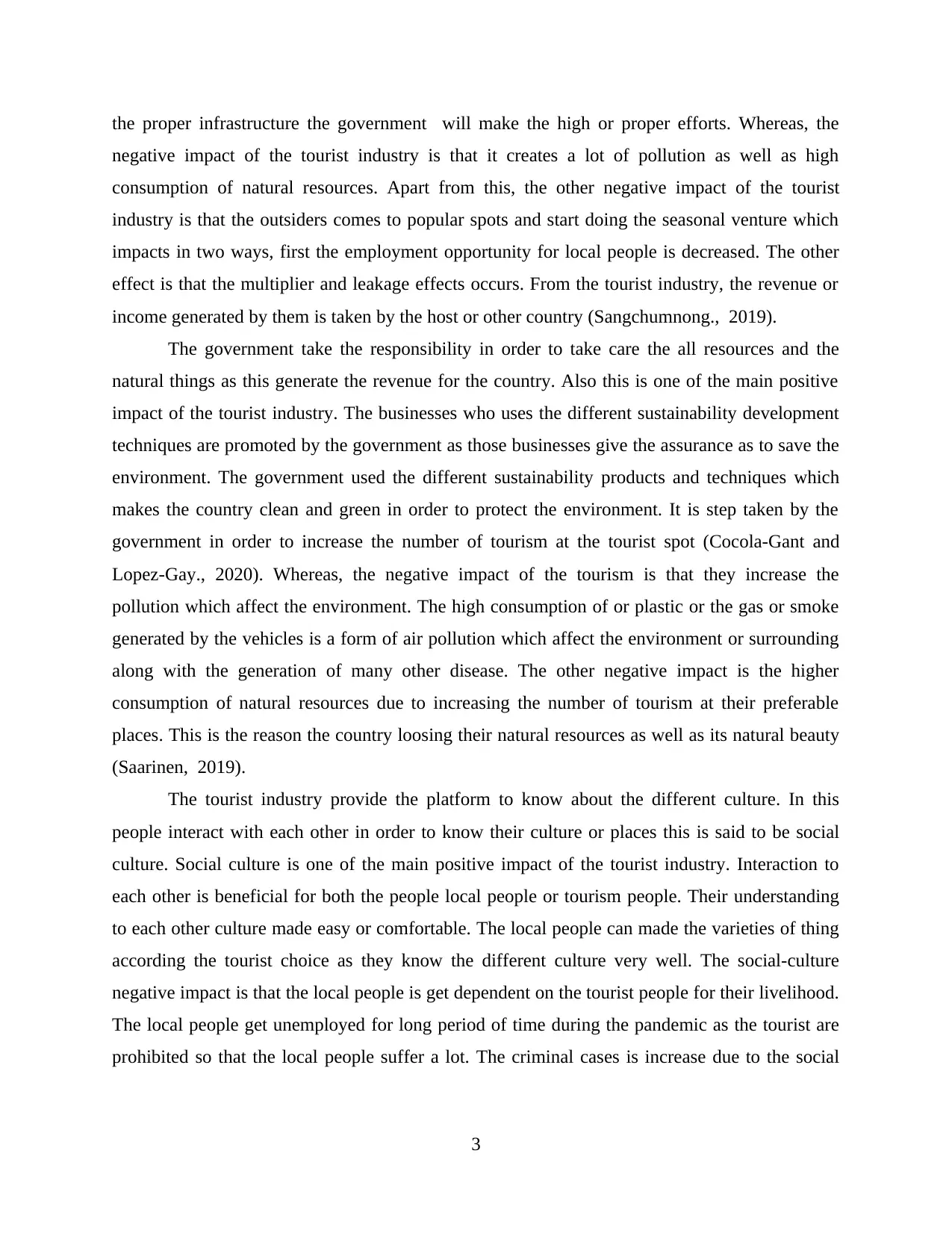
the proper infrastructure the government will make the high or proper efforts. Whereas, the
negative impact of the tourist industry is that it creates a lot of pollution as well as high
consumption of natural resources. Apart from this, the other negative impact of the tourist
industry is that the outsiders comes to popular spots and start doing the seasonal venture which
impacts in two ways, first the employment opportunity for local people is decreased. The other
effect is that the multiplier and leakage effects occurs. From the tourist industry, the revenue or
income generated by them is taken by the host or other country (Sangchumnong., 2019).
The government take the responsibility in order to take care the all resources and the
natural things as this generate the revenue for the country. Also this is one of the main positive
impact of the tourist industry. The businesses who uses the different sustainability development
techniques are promoted by the government as those businesses give the assurance as to save the
environment. The government used the different sustainability products and techniques which
makes the country clean and green in order to protect the environment. It is step taken by the
government in order to increase the number of tourism at the tourist spot (Cocola-Gant and
Lopez-Gay., 2020). Whereas, the negative impact of the tourism is that they increase the
pollution which affect the environment. The high consumption of or plastic or the gas or smoke
generated by the vehicles is a form of air pollution which affect the environment or surrounding
along with the generation of many other disease. The other negative impact is the higher
consumption of natural resources due to increasing the number of tourism at their preferable
places. This is the reason the country loosing their natural resources as well as its natural beauty
(Saarinen, 2019).
The tourist industry provide the platform to know about the different culture. In this
people interact with each other in order to know their culture or places this is said to be social
culture. Social culture is one of the main positive impact of the tourist industry. Interaction to
each other is beneficial for both the people local people or tourism people. Their understanding
to each other culture made easy or comfortable. The local people can made the varieties of thing
according the tourist choice as they know the different culture very well. The social-culture
negative impact is that the local people is get dependent on the tourist people for their livelihood.
The local people get unemployed for long period of time during the pandemic as the tourist are
prohibited so that the local people suffer a lot. The criminal cases is increase due to the social
3
negative impact of the tourist industry is that it creates a lot of pollution as well as high
consumption of natural resources. Apart from this, the other negative impact of the tourist
industry is that the outsiders comes to popular spots and start doing the seasonal venture which
impacts in two ways, first the employment opportunity for local people is decreased. The other
effect is that the multiplier and leakage effects occurs. From the tourist industry, the revenue or
income generated by them is taken by the host or other country (Sangchumnong., 2019).
The government take the responsibility in order to take care the all resources and the
natural things as this generate the revenue for the country. Also this is one of the main positive
impact of the tourist industry. The businesses who uses the different sustainability development
techniques are promoted by the government as those businesses give the assurance as to save the
environment. The government used the different sustainability products and techniques which
makes the country clean and green in order to protect the environment. It is step taken by the
government in order to increase the number of tourism at the tourist spot (Cocola-Gant and
Lopez-Gay., 2020). Whereas, the negative impact of the tourism is that they increase the
pollution which affect the environment. The high consumption of or plastic or the gas or smoke
generated by the vehicles is a form of air pollution which affect the environment or surrounding
along with the generation of many other disease. The other negative impact is the higher
consumption of natural resources due to increasing the number of tourism at their preferable
places. This is the reason the country loosing their natural resources as well as its natural beauty
(Saarinen, 2019).
The tourist industry provide the platform to know about the different culture. In this
people interact with each other in order to know their culture or places this is said to be social
culture. Social culture is one of the main positive impact of the tourist industry. Interaction to
each other is beneficial for both the people local people or tourism people. Their understanding
to each other culture made easy or comfortable. The local people can made the varieties of thing
according the tourist choice as they know the different culture very well. The social-culture
negative impact is that the local people is get dependent on the tourist people for their livelihood.
The local people get unemployed for long period of time during the pandemic as the tourist are
prohibited so that the local people suffer a lot. The criminal cases is increase due to the social
3
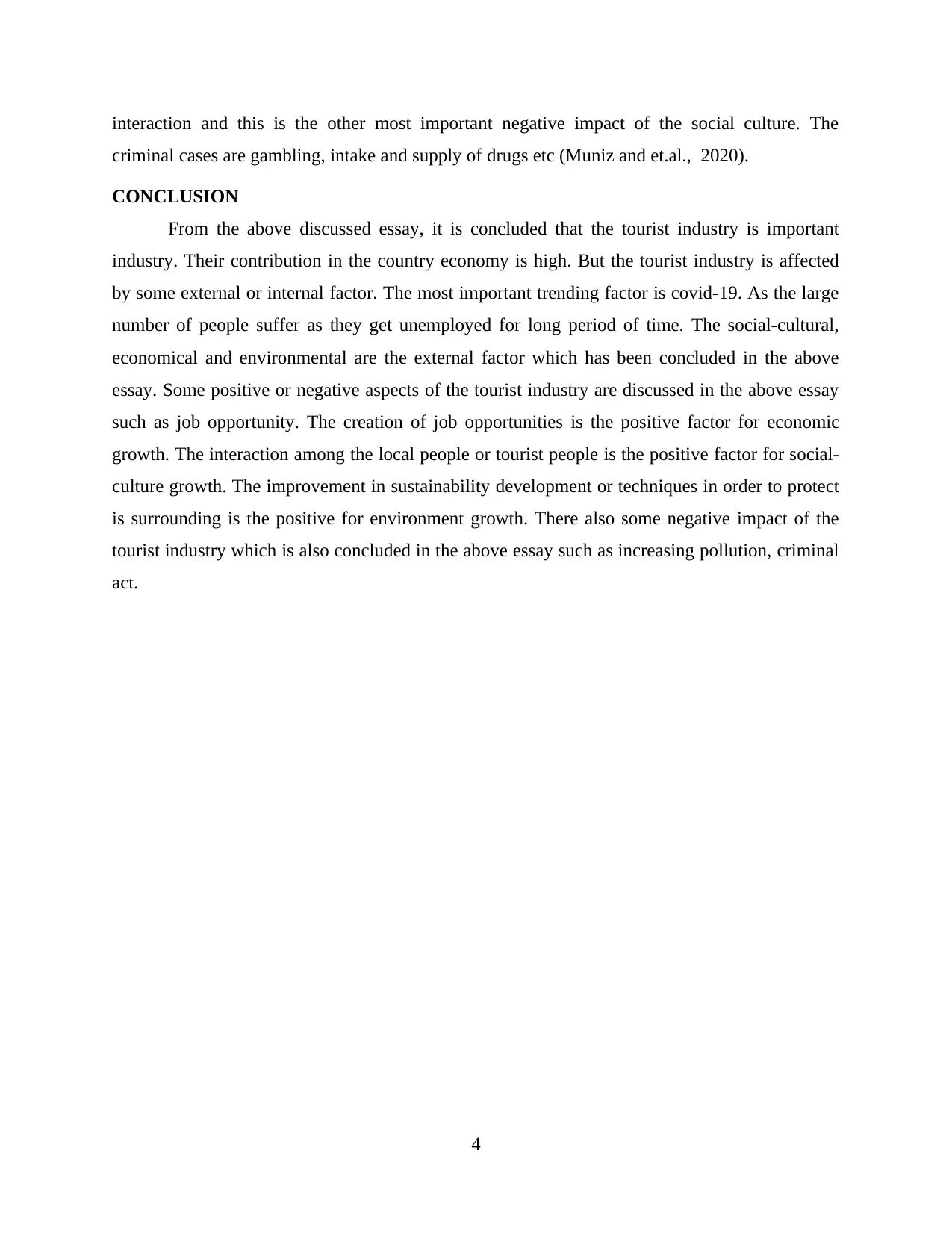
interaction and this is the other most important negative impact of the social culture. The
criminal cases are gambling, intake and supply of drugs etc (Muniz and et.al., 2020).
CONCLUSION
From the above discussed essay, it is concluded that the tourist industry is important
industry. Their contribution in the country economy is high. But the tourist industry is affected
by some external or internal factor. The most important trending factor is covid-19. As the large
number of people suffer as they get unemployed for long period of time. The social-cultural,
economical and environmental are the external factor which has been concluded in the above
essay. Some positive or negative aspects of the tourist industry are discussed in the above essay
such as job opportunity. The creation of job opportunities is the positive factor for economic
growth. The interaction among the local people or tourist people is the positive factor for social-
culture growth. The improvement in sustainability development or techniques in order to protect
is surrounding is the positive for environment growth. There also some negative impact of the
tourist industry which is also concluded in the above essay such as increasing pollution, criminal
act.
4
criminal cases are gambling, intake and supply of drugs etc (Muniz and et.al., 2020).
CONCLUSION
From the above discussed essay, it is concluded that the tourist industry is important
industry. Their contribution in the country economy is high. But the tourist industry is affected
by some external or internal factor. The most important trending factor is covid-19. As the large
number of people suffer as they get unemployed for long period of time. The social-cultural,
economical and environmental are the external factor which has been concluded in the above
essay. Some positive or negative aspects of the tourist industry are discussed in the above essay
such as job opportunity. The creation of job opportunities is the positive factor for economic
growth. The interaction among the local people or tourist people is the positive factor for social-
culture growth. The improvement in sustainability development or techniques in order to protect
is surrounding is the positive for environment growth. There also some negative impact of the
tourist industry which is also concluded in the above essay such as increasing pollution, criminal
act.
4
⊘ This is a preview!⊘
Do you want full access?
Subscribe today to unlock all pages.

Trusted by 1+ million students worldwide

REFERENCES
Books and Journals:
Alrawadieh, Z., Karayilan, E. and Cetin, G., 2019. Understanding the challenges of refugee
entrepreneurship in tourism and hospitality. The Service Industries Journal, 39(9-10),
pp.717-740.
Bittar Rodrigues, C. and Prideaux, B., 2018. A management model to assist local communities
developing community-based tourism ventures: a case study from the Brazilian
Amazon. Journal of Ecotourism, 17(1), pp.1-19.
Chong, K.L., 2020. The side effects of mass tourism: the voices of Bali islanders. Asia Pacific
Journal of Tourism Research, 25(2), pp.157-169.
Christou, P., Simillidou, A. and Stylianou, M.C., 2020. Tourists’ perceptions regarding the use of
anthropomorphic robots in tourism and hospitality. International Journal of
Contemporary Hospitality Management.
Cocola-Gant, A. and Lopez-Gay, A., 2020. Transnational gentrification, tourism and the
formation of ‘foreign only’enclaves in Barcelona. Urban studies, 57(15), pp.3025-3043.
Crespi-Vallbona, M. and Mascarilla-Miró, O., 2020. Wine lovers: their interests in tourist
experiences. International Journal of Culture, Tourism and Hospitality Research.
Hateftabar, F. and Chapuis, J.M., 2020. How resident perception of economic crisis influences
their perception of tourism. Journal of Hospitality and Tourism Management, 43,
pp.157-168.
Jones, C.R. and Walmsley, A., 2022. A change would do you good: advances in research impact
in sustainable tourism and some ‘home truths’ for the sector. Journal of Sustainable
Tourism, 30(9), pp.2073-2088.
Muniz, E.C.L., Dandolini, G.A., Biz, A.A. and Ribeiro, A.C., 2020. Customer knowledge
management and smart tourism destinations: a framework for the smart management of
the tourist experience–SMARTUR. Journal of Knowledge Management.
Nguyen, T.Q.T., Johnson, P. and Young, T., 2022. Networking, coopetition and sustainability of
tourism destinations. Journal of Hospitality and Tourism Management, 50, pp.400-411.
Phelan, A., Ruhanen, L. and Mair, J., 2020. Ecosystem services approach for community-based
ecotourism: towards an equitable and sustainable blue economy. Journal of Sustainable
Tourism, 28(10), pp.1665-1685.
Qian, J., Wei, J. and Law, R., 2018. Review of critical discourse analysis in tourism
studies. International Journal of Tourism Research, 20(4), pp.526-537.
Saarinen, J., 2019. What are wilderness areas for? Tourism and political ecologies of wilderness
uses and management in the Anthropocene. Journal of Sustainable Tourism, 27(4),
pp.472-487.
Sangchumnong, A., 2019. Development of a sustainable tourist destination based on the creative
economy: A case study of Klong Kone Mangrove Community, Thailand. Kasetsart
Journal of Social Sciences, 40(3), pp.642-649.
Thompson, B.S., Gillen, J. and Friess, D.A., 2018. Challenging the principles of ecotourism:
insights from entrepreneurs on environmental and economic sustainability in Langkawi,
Malaysia. Journal of Sustainable Tourism, 26(2), pp.257-276.
5
Books and Journals:
Alrawadieh, Z., Karayilan, E. and Cetin, G., 2019. Understanding the challenges of refugee
entrepreneurship in tourism and hospitality. The Service Industries Journal, 39(9-10),
pp.717-740.
Bittar Rodrigues, C. and Prideaux, B., 2018. A management model to assist local communities
developing community-based tourism ventures: a case study from the Brazilian
Amazon. Journal of Ecotourism, 17(1), pp.1-19.
Chong, K.L., 2020. The side effects of mass tourism: the voices of Bali islanders. Asia Pacific
Journal of Tourism Research, 25(2), pp.157-169.
Christou, P., Simillidou, A. and Stylianou, M.C., 2020. Tourists’ perceptions regarding the use of
anthropomorphic robots in tourism and hospitality. International Journal of
Contemporary Hospitality Management.
Cocola-Gant, A. and Lopez-Gay, A., 2020. Transnational gentrification, tourism and the
formation of ‘foreign only’enclaves in Barcelona. Urban studies, 57(15), pp.3025-3043.
Crespi-Vallbona, M. and Mascarilla-Miró, O., 2020. Wine lovers: their interests in tourist
experiences. International Journal of Culture, Tourism and Hospitality Research.
Hateftabar, F. and Chapuis, J.M., 2020. How resident perception of economic crisis influences
their perception of tourism. Journal of Hospitality and Tourism Management, 43,
pp.157-168.
Jones, C.R. and Walmsley, A., 2022. A change would do you good: advances in research impact
in sustainable tourism and some ‘home truths’ for the sector. Journal of Sustainable
Tourism, 30(9), pp.2073-2088.
Muniz, E.C.L., Dandolini, G.A., Biz, A.A. and Ribeiro, A.C., 2020. Customer knowledge
management and smart tourism destinations: a framework for the smart management of
the tourist experience–SMARTUR. Journal of Knowledge Management.
Nguyen, T.Q.T., Johnson, P. and Young, T., 2022. Networking, coopetition and sustainability of
tourism destinations. Journal of Hospitality and Tourism Management, 50, pp.400-411.
Phelan, A., Ruhanen, L. and Mair, J., 2020. Ecosystem services approach for community-based
ecotourism: towards an equitable and sustainable blue economy. Journal of Sustainable
Tourism, 28(10), pp.1665-1685.
Qian, J., Wei, J. and Law, R., 2018. Review of critical discourse analysis in tourism
studies. International Journal of Tourism Research, 20(4), pp.526-537.
Saarinen, J., 2019. What are wilderness areas for? Tourism and political ecologies of wilderness
uses and management in the Anthropocene. Journal of Sustainable Tourism, 27(4),
pp.472-487.
Sangchumnong, A., 2019. Development of a sustainable tourist destination based on the creative
economy: A case study of Klong Kone Mangrove Community, Thailand. Kasetsart
Journal of Social Sciences, 40(3), pp.642-649.
Thompson, B.S., Gillen, J. and Friess, D.A., 2018. Challenging the principles of ecotourism:
insights from entrepreneurs on environmental and economic sustainability in Langkawi,
Malaysia. Journal of Sustainable Tourism, 26(2), pp.257-276.
5
Paraphrase This Document
Need a fresh take? Get an instant paraphrase of this document with our AI Paraphraser
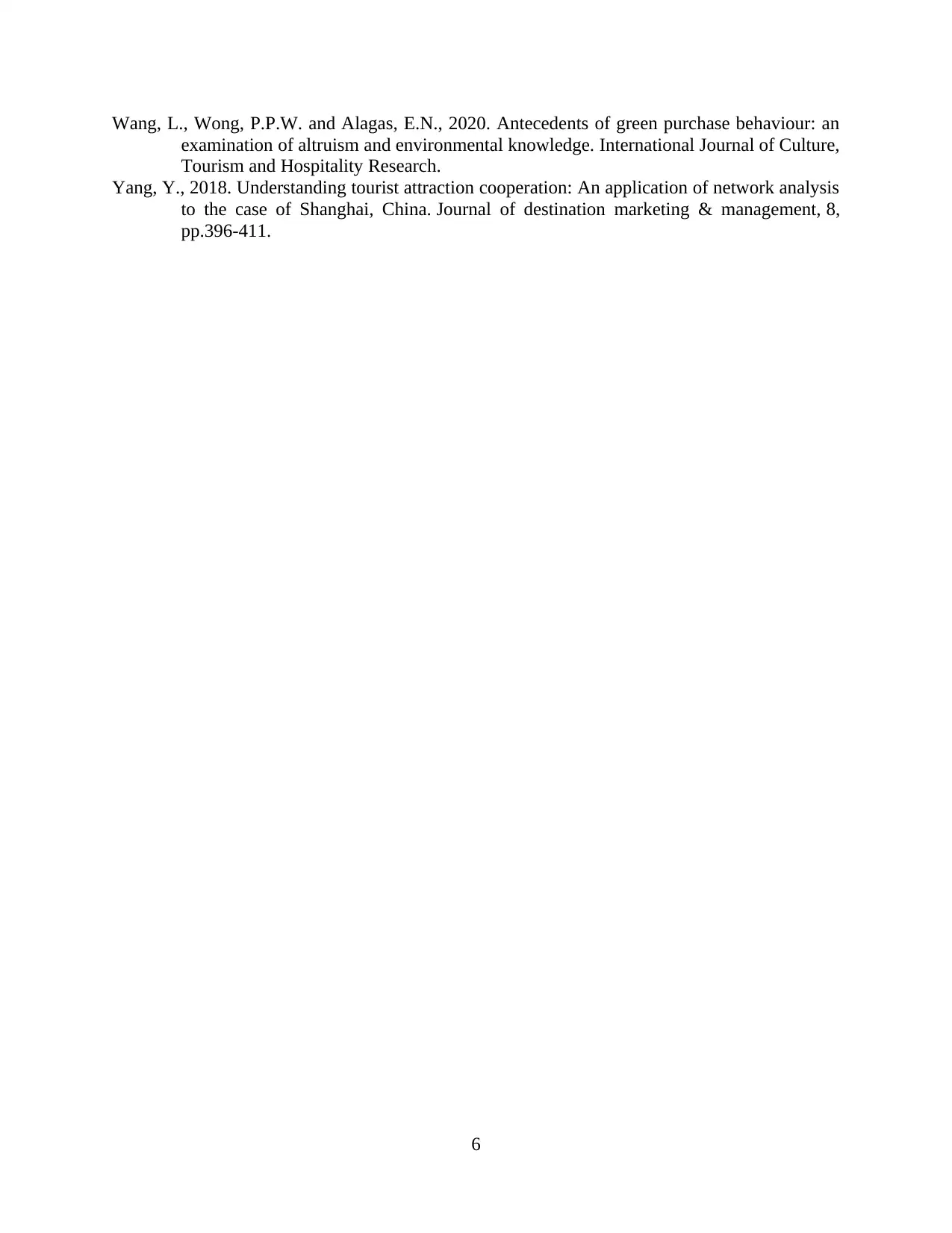
Wang, L., Wong, P.P.W. and Alagas, E.N., 2020. Antecedents of green purchase behaviour: an
examination of altruism and environmental knowledge. International Journal of Culture,
Tourism and Hospitality Research.
Yang, Y., 2018. Understanding tourist attraction cooperation: An application of network analysis
to the case of Shanghai, China. Journal of destination marketing & management, 8,
pp.396-411.
6
examination of altruism and environmental knowledge. International Journal of Culture,
Tourism and Hospitality Research.
Yang, Y., 2018. Understanding tourist attraction cooperation: An application of network analysis
to the case of Shanghai, China. Journal of destination marketing & management, 8,
pp.396-411.
6
1 out of 8
Related Documents
Your All-in-One AI-Powered Toolkit for Academic Success.
+13062052269
info@desklib.com
Available 24*7 on WhatsApp / Email
![[object Object]](/_next/static/media/star-bottom.7253800d.svg)
Unlock your academic potential
Copyright © 2020–2025 A2Z Services. All Rights Reserved. Developed and managed by ZUCOL.

